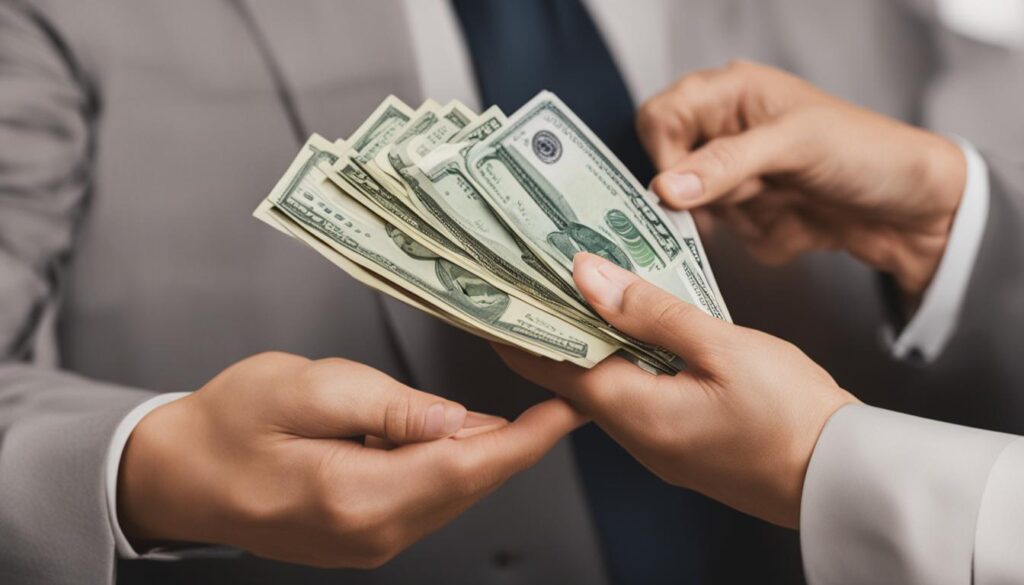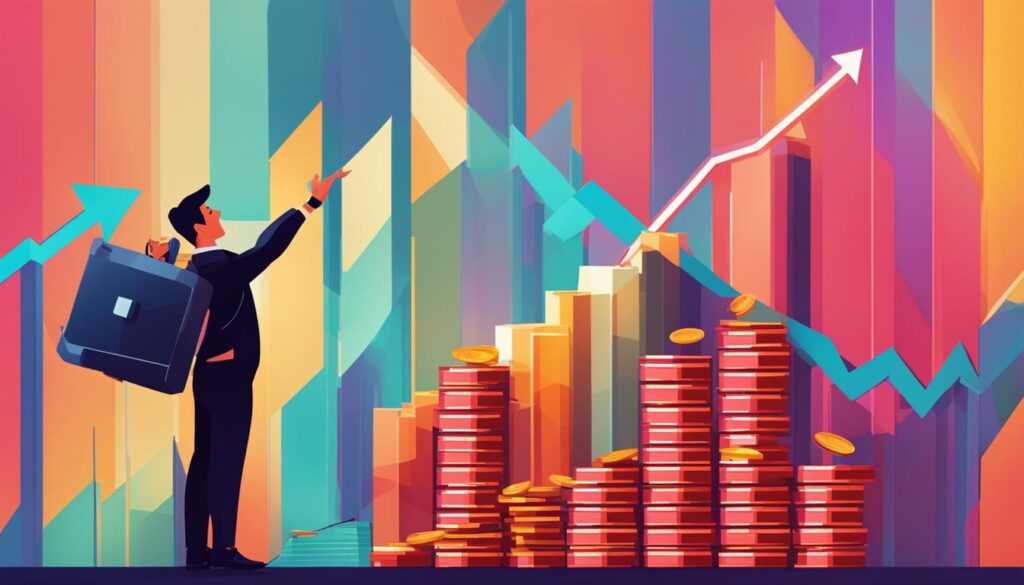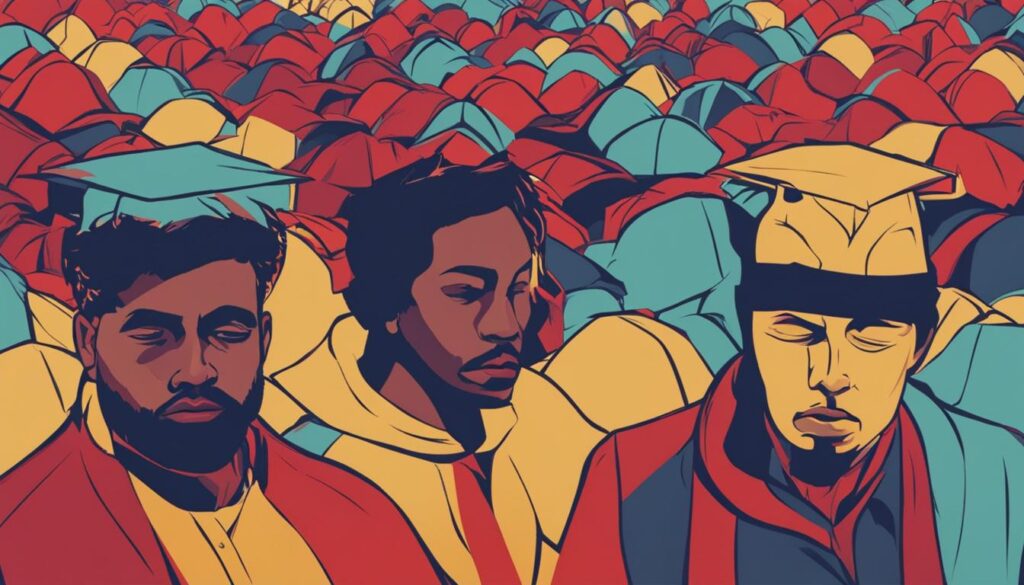High-interest debt can be a financial burden, and finding effective strategies for reducing it is crucial for achieving financial relief. Whether it’s credit card debt, personal loans, or private student loans, these unsecured debts often come with astronomical interest rates that can hinder your financial progress. In this article, we will explore practical strategies to help you tackle your high-interest debt head-on and pave the way towards a debt-free future.
Key Takeaways:
- Reducing high-interest debt requires effective strategies like debt consolidation and making more than minimum payments.
- Unchecked high-interest debt can negatively impact credit health and hinder progress towards other financial goals.
- Understanding the financial implications of high-interest debt and compound interest payments is crucial.
- Prioritizing debts with higher interest rates and maintaining a low credit utilization ratio can aid in reducing high-interest debt.
- A budget helps track income and expenses, enabling individuals to allocate more money towards debt payments.
Understanding High-Interest Debt
High-interest debt refers to debts with interest rates above the average rates for mortgages and student loans. It primarily includes unsecured debts, such as credit cards, personal loans, and private student loans, that often carry high-interest rates. These debts can significantly increase the overall cost of borrowing due to compound interest payments. It is important to understand the financial implications of high-interest debt and its effect on credit utilization ratio.
Unmanaged high-interest debt can have a negative impact on credit health, increasing borrowing costs and potentially damaging credit scores. Compound interest, which is interest on both the principal amount and any accumulated interest, can quickly accumulate and make it challenging to pay off the debt. This can result in a cycle of debt, making it difficult to achieve financial stability and meet other financial goals.
One important factor to consider in managing high-interest debt is the credit utilization ratio. This ratio compares the amount of credit you are using to the total amount of credit available to you. A high credit utilization ratio, especially when combined with high-interest debt, can have a negative impact on credit scores. Lenders view high credit utilization as a sign of financial risk, which can make it harder to secure loans or credit in the future at favorable interest rates.
Having a clear understanding of high-interest debt and its consequences can help individuals make informed decisions about managing their finances. By implementing effective debt reduction strategies and maintaining a healthy credit utilization ratio, individuals can work towards paying off their debt, improving their credit health, and achieving long-term financial goals.
Strategies for Paying Off High-Interest Debt
When it comes to paying off high-interest debt, it’s important to have a clear plan and employ effective strategies. By taking the following steps, individuals can make significant progress towards reducing their debt:
- Make more than the minimum payments: Simply paying the minimum amount due each month can result in a lengthy repayment period and substantial interest charges. By increasing your monthly payments, you can accelerate debt reduction and save on interest costs.
- Utilize the debt avalanche method: The debt avalanche method involves prioritizing debts with the highest interest rates. By focusing on paying off these debts first, you can minimize interest expenses and pay down your overall debt faster.
- Consider debt consolidation: If you have multiple sources of high-interest debt, such as credit cards and personal loans, debt consolidation can simplify your repayment process. This involves combining all your debts into a single loan or credit card with a lower interest rate. However, it’s important to carefully evaluate the terms and potential drawbacks of debt consolidation before proceeding.
- Maintain a low credit utilization ratio: Your credit utilization ratio is the amount of credit you’re currently using compared to your total available credit. Keeping this ratio low can positively impact your credit health and make it easier to pay off high-interest debt. To achieve this, focus on paying down your balances and avoid maxing out your credit cards.
By implementing these strategies, individuals can take control of their high-interest debt and work towards a debt-free future. It’s important to stay committed, remain disciplined, and make consistent efforts to reduce your debt. Remember, financial freedom is within reach with the right mindset and the right strategies.
Importance of Budgeting
Creating and sticking to a budget is crucial for reducing high-interest debt. A budget helps track income and expenses, enabling individuals to identify areas where they can cut back and allocate more money towards debt payments. By maintaining a budget, individuals can take control of their finances and work towards achieving their financial goals.
One effective tool for managing spending and staying within budgeted amounts is the cash envelope system. This system involves dividing cash into different envelopes for different spending categories, such as groceries, transportation, and entertainment. With the cash envelope system, individuals have a visual representation of how much money they have allocated for each category, which helps them make conscious spending decisions and avoid overspending.
Benefits of the Cash Envelope System:
- Allows for better control of spending habits
- Prevents reliance on credit cards and accumulating new debt
- Encourages mindful spending and prioritizing financial goals
- Provides a tangible reminder of financial limits
- Motivates individuals to find creative ways to stretch their dollars
By establishing a budget and controlling spending habits through tools like the cash envelope system, individuals can free up more funds for debt repayment. This proactive approach to managing finances sets the stage for long-term financial success and paves the way to becoming debt-free.
| Expense Category | Budgeted Amount | Actual Spent Amount |
|---|---|---|
| Groceries | $300 | $280 |
| Transportation | $200 | $220 |
| Entertainment | $100 | $80 |
The table above demonstrates how a budget can be structured to track expenses in different categories. By comparing the budgeted amount with the actual spent amount, individuals can identify areas where they may be overspending and make adjustments accordingly. This level of detail and tracking is essential for effective budgeting and debt reduction.

“A budget is telling your money where to go instead of wondering where it went.” – Dave Ramsey
Increasing Income
To expedite the process of paying off high-interest debt, individuals can explore various options to increase their income. By generating extra funds, they can allocate more towards debt repayment, accelerating their progress towards financial freedom.
Part-Time Jobs
One popular approach is taking on a part-time job. This allows individuals to earn additional income without committing to a full-time position. Part-time jobs can range from retail or hospitality roles to freelance work in various industries. By dedicating a few extra hours each week, individuals can significantly boost their monthly income, creating more opportunities to pay off debt.
Side Hustles
Another avenue to consider is exploring side hustles. Side hustles are flexible, part-time endeavors that individuals can pursue alongside their regular jobs or other commitments. These can include freelancing, tutoring, dog walking, or selling handmade crafts online. Side hustles offer the potential for extra income and can be an avenue for individuals to monetize their skills and hobbies.
Entrepreneurship
For those seeking greater control over their income, entrepreneurship may be an attractive option. Starting a small business or leveraging existing skills can create opportunities for generating additional revenue. While entrepreneurship requires dedication and hard work, it can provide the potential for long-term financial stability and independence.
Increasing income through part-time jobs, side hustles, or entrepreneurship requires careful consideration of individual circumstances and personal preferences. By evaluating available options and choosing the most suitable approach, individuals can effectively boost their income and accelerate their journey towards becoming debt-free.

Changing Mindset and Habits
Successfully reducing high-interest debt requires a shift in mindset and the development of healthier financial habits. Adopting a positive mindset and believing in the possibility of becoming debt-free is crucial for achieving financial freedom.
One important habit to break is the comparison game. It’s easy to get caught up in comparing ourselves to others and feeling the pressure to keep up with their spending habits. However, this only leads to unnecessary debt and financial stress. Instead, focus on your personal financial goals and the progress you are making towards becoming debt-free.
“The only person you should try to be better than is the person you were yesterday.” – Unknown
Another habit to change is relying on credit cards. Credit cards can be convenient, but they also make it easier to overspend and accumulate more debt. Consider cutting up your credit cards and switching to a cash-based transaction system. This way, you only spend the money you actually have and avoid the temptation to rely on credit.
By changing your mindset and developing healthier financial habits, you can avoid unnecessary debt and stay on track towards your goal of becoming debt-free.

Sacrifices and Lifestyle Changes
Making sacrifices and embracing lifestyle changes are essential steps towards reducing high-interest debt. By implementing these strategies, individuals can free up more funds for debt repayment and accelerate their journey towards financial freedom.
1. Downsizing Car Payments
One significant lifestyle shift that can have a positive impact on debt reduction is downsizing car payments. Consider trading in your current vehicle for a more affordable option, or even exploring alternatives such as public transportation or car-sharing services. By reducing the monthly expense of car payments, you can allocate those funds towards paying off high-interest debt.
2. Reducing Unnecessary Expenses
Another sacrifice that may be necessary is cutting back on unnecessary expenses. Take a close look at your monthly budget and identify areas where you can make adjustments. This could involve eliminating subscriptions or memberships that you no longer use, or finding ways to save on utilities, groceries, and entertainment expenses. By making conscious choices and prioritizing debt reduction, you can redirect those saved funds towards paying off high-interest debt.
3. Temporarily Pausing Retirement Savings
While it’s important to prioritize saving for retirement, if you are burdened with high-interest debt, it may be necessary to temporarily pause contributions to your retirement savings. By redirecting those funds towards debt repayment, you can make significant progress in reducing your debt load. However, it’s crucial to revisit your retirement savings plan once your high-interest debt is under control to ensure you continue to work towards long-term financial security.
Remember, these sacrifices and lifestyle changes are temporary measures aimed at achieving a more stable financial future. By making these adjustments and staying committed to your debt reduction goals, you can overcome high-interest debt and pave the way for a brighter financial future.
Conclusion
Achieving a debt-free lifestyle and attaining financial freedom is possible through effective debt reduction strategies. By implementing strategies such as making more than minimum payments, utilizing the debt avalanche method, and considering debt consolidation, individuals can make significant progress in reducing high-interest debt.
Consistency, discipline, and a positive mindset are key to successfully paying off debt and achieving long-term financial goals. With determination and the right strategies, the burden of high-interest debt can be lifted, leading to a brighter financial future.
So, if you’re ready to take control of your finances and become debt-free, start implementing these strategies today. Remember, it’s not just about the destination, but the journey towards financial freedom. Stay focused, stay committed, and you’ll soon be on your way to a debt-free life!
FAQ
What is high-interest debt?
High-interest debt refers to debts with interest rates above the average rates for mortgages and student loans. Unsecured debts like credit cards, personal loans, and private student loans often carry high-interest rates.
Why is it important to reduce high-interest debt?
High-interest debt can be a financial burden and managing it is crucial for achieving financial relief. Unchecked high-interest debt can negatively impact credit health and delay progress towards other financial goals.
What strategies can be used to reduce high-interest debt?
Strategies for reducing high-interest debt include making more than the minimum monthly payment, utilizing the debt avalanche method, and considering debt consolidation.
How can budgeting help with reducing high-interest debt?
Creating and sticking to a budget helps track income and expenses, enabling individuals to identify areas where they can cut back and allocate more money towards debt payments.
How can increasing income contribute to paying off high-interest debt?
Taking on a part-time job, engaging in side hustles, or utilizing existing skills and talents can provide additional funds to allocate towards debt repayment.
How can changing mindset and habits help with reducing high-interest debt?
Adopting a positive mindset, avoiding the comparison game, and focusing on personal financial goals can help stay on track. Cutting up credit cards and relying on cash-based transactions can discourage the accumulation of new debt and promote responsible spending habits.
What sacrifices and lifestyle changes can be made to reduce high-interest debt?
Consider downsizing car payments, reducing unnecessary expenses, and eliminating non-essential spending. Temporarily pausing contributions to retirement savings can free up funds for debt repayment.
Is it possible to achieve a debt-free lifestyle and financial freedom?
Yes, with determination and the right strategies, the burden of high-interest debt can be lifted, leading to a brighter financial future.
What Non-Essentials Can I Cut from My Spending to Reduce Debt?
To reduce debt, it is crucial to evaluate and cut non-essential spending before recession hits. Identify areas where you can trim expenses, such as dining out, entertainment subscriptions, or impulsive shopping. Prioritizing needs over wants can significantly contribute to debt reduction and overall financial stability. Being proactive in curbing non-essential spending helps create a solid foundation for a healthier financial future.

